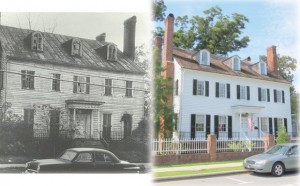
New Bern Historical Society Curator Jim Hodges recently encountered a photo of the Attmore Oliver House at 511 Broad Street from 1950 showing the house in a rather dilapidated condition. Considering what it looked like then, and its appearance now, Jim explains the history of one of New Bern’s oldest homes:
The future home of the New Bern Historical Society started its long journey about 1790 when Samuel Chapman, a veteran of the Continental Army and later the Clerk of the Craven County Superior Court, built a simple story-and-a-half frame house. Chapman purchased the lot on Broad Street in September, 1790 from Nicholas and Elizabeth Bray of Jones County. In 1803, Chapman’s wife Christiana died leaving two children, Nancy and Henry Lee. He later married Catherine Backhouse and they had two children, Caroline Eliza and Samuel Edward Chapman. The elder Samuel Chapman died in March, 1807 and the house eventually passed on to his daughter Caroline Eliza.
In 1834, Caroline Eliza and her husband Henry P. Waring, a New York merchant, sold the house to Isaac Taylor, a prominent and successful New Bern businessman. Although the Taylor Family resided on Craven Street, Isaac Taylor also owned a large Craven County plantation named “GlenBurnie.” The original Chapman house was majorly renovated to the present structure and was occupied by his daughter Mary, her husband George Sitgreaves Attmore, and eventually seven children. When Isaac Taylor died July 4, 1846, the house was willed to his daughter Mary Taylor Attmore.
George Attmore was a successful lawyer and his large family prospered despite Mary Taylor Attmore’s untimely death in 1852 at the age of 45. The family remained in the house until George Attmore’s death in December 1859. Hannah Taylor Attmore, daughter of Mary and George Attmore, married William Hollister Oliver in 1854 and inherited the house after her father’s death. William H. Oliver was a merchant, Mason and a respected community leader. Hannah and William had eight children, sadly three died in infancy.
The political and economic events surrounding the Civil War obviously impacted the normalcy of life for the Attmore-Oliver families. All three of Hannah’s brothers enlisted in the Confederate Army, two losing their lives as a result of the conflict. It is unclear if the family continued to live in the house during the Civil War and Union Occupation due to the fact that medical supplies and related artifacts were discovered in an archaeological investigation in the basement in 1962 suggesting that possibly the house was used as a Union Hospital. Regardless, the Attmore-Oliver family did not lose their home, they endured reconstruction, and life eventually approached normalcy.
It is noted that in 1880 there were eleven family members residing in the Attmore-Oliver House, clearly indicating an active household. Hannah Attmore-Oliver died in 1881 leaving the house to her four daughters. William H. Oliver continued to live with his family and pursued a full-time career selling insurance. After his death in 1908 the house eventually succeeded to his unmarried daughter, Mary Taylor Oliver. Miss Mary was known as a ‘spunky’ lady who continued her father’s insurance business for many years and also rented rooms in the Attmore-Oliver House to single female teachers possibly 1915-1940. It is worthy to note that one of her long term boarders was Miss Mary Hall Heath who was a much revered first grade school teacher. She was so respected and loved by her students and the community that a special cedar tree was planted in her honor and memory in the Christ Church yard—the Molly Heath Tree.
In failing health, Miss Mary Oliver spent several years in St. Luke’s Hospital just down the street from her home and died March 13, 1951. She was blessed in having spent most of her life of 91 years in the Attmore-Oliver House. In her will, Miss Mary left her home to her five nephews—the four Huske brothers in Fayetteville and Henry Constable. Although the Attmore-Oliver House was in severe disrepair, its great potential as a permanent home for the New Bern Historical Society was recognized and pursued with the leadership of Mr. John R. Taylor and Mr. John G. Dunn who drove to Fayetteville and negotiated the purchase of the Broad Street property for the sum of $30,000. The transaction was completed in 1954. An additional sum of $30,000 was invested to restore and refurbish the House. Amazingly, the total debt was retired with a ‘mortgage burning ceremony’ on March 20, 1963. With commitment, passion, and unwavering determination the New Bern Historical Society accomplished its mission of preserving the Attmore-Oliver House., which now houses museum displays as well as the Society offices. The spirit of stewardship is alive and well. For more information about the New Bern Historical Society call 252-638-8558 or go to www.NewBernHistorical.org.
Submitted by: Kathy Morrison for the New Bern Historical Society, 511 Broad Street, New Bern, NC, 252-638-8558

